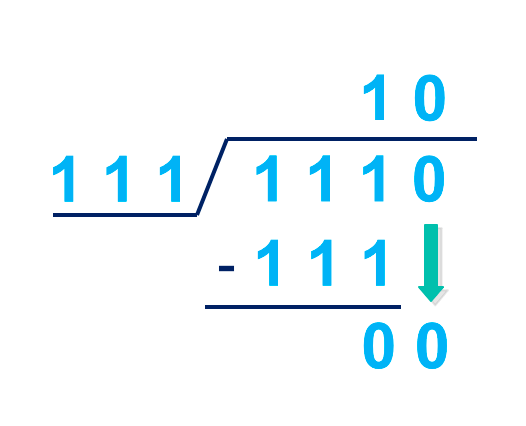Topic Content:
- Division of Number Bases
- Long Division Method
- Alternative Method
Example 2.2.1:
Divide the following numbers:
a. 1110two ÷ 111two
b. 1010two ÷ 10two
c. 1101001two ÷ 101two
Solution
The long division method is one of the most efficient and easiest ways to solve binary division.
Remember these rules
- The dividend is divided by the divisor, and the answer is the quotient.
- Compare the divisor to the first digit in the dividend. If the divisor is the larger number, keep adding digits to the dividend until the divisor is the smaller number. (For example, if calculating 156 ÷ 2, we would compare 2 and 1, note that 2 > 1, and compare 2 to 15 instead.)
a. 1110two ÷ 111two

Explanation
111 is the divisor, 1110 is the dividend.
Compare the divisor (111) to the dividend (1110) from the first digit.
111 > 1 so we carry on (or add a 0)
111 > 11 so we carry on (or add a 0)
111 = 111, This can be divided. We write 1 in the quotient.
Like standard division, we then multiply the divisor (111) by 1 and then find the remainder by subtracting the result.
The remainder is 0 and the number brought down is 0. What we have now is 00.
We then try and divide again. 111 > 00 so we add a 0 to the quotient.
0010two = 10two
Answer = 10two
b. 1010two ÷ 10two
You are viewing an excerpt of this Topic. Subscribe Now to get Full Access to ALL this Subject's Topics and Quizzes for this Term!
Click on the button "Subscribe Now" below for Full Access!
Subscribe Now
Note: If you have Already Subscribed and you are seeing this message, it means you are logged out. Please Log In using the Login Button Below to Carry on Studying!



This is cool.
Easy to understand ☺️
pls how did you get 1.173 in example 2 question i ???
(1111.01 ÷ 1101) convert to base 10
= 15.25 ÷ 13 = 1.173
Thanks